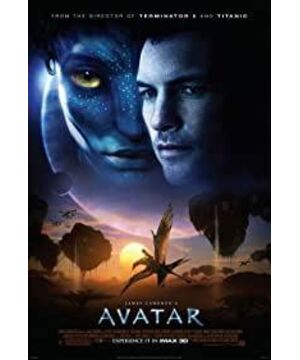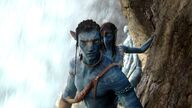14 years, waiting has become a habit. After "Titanic" was submerged gorgeously in the money pile, James Cameron transformed from "King of the World" to "King of Bouncing Tickets." Smoke bombs have stirred up expectations in the hearts of movie fans again and again, but again and again confidently let go of all the pigeons. Fortunately, this great director, known for his harsh cold-blooded and perfectionism, did not disappoint fans who have been following for many years: At the end of 2009, the "most expensive" film "Avatar", which cost 500 million US dollars, was finally overdue. As soon as he showed up, it detonated the fans' excitement and almost incoherent shouts-"The new era of movies has arrived!"
The word "Avatar" comes from Sanskrit, and its original meaning is "the incarnation of god" in Indian mythology; it was later extended. Enter the network world, used to refer to the user's image settings in the virtual environment. This sci-fi term is undoubtedly in line with Cameron’s own taste: after all, Cameron has had an almost crazy love for science fiction since childhood, and when he was a truck driver and a takeaway kid, "Star Wars" "The birth of "has planted a lifelong dream in his heart-shooting his own science fiction movie.
The first draft of the "Avatar" script was completed in 1995, and the version we see today has not changed much: a half-paralyzed military veteran, Jake Sully, was dispatched to a planet named Pandora On the previous page, by controlling the avatar "Avatar" that merged the DNA of himself and the aliens into the local Na'vi ethnic group, trying to persuade them to move out of their homeland so that the earth people can develop the rare minerals hidden underground; along with the alien world Gradually deepened his understanding, Jack began to doubt his mission, and when the final violent conflict broke out, he resolutely turned back and led the Nabi tribe to defeat the invasion of the earthlings. In a nutshell, this story is like an ordinary action movie dressed in science fiction. However, the label Cameron reminds us not to take it lightly. As Cameron himself admitted, "My source of inspiration is very single, basically science fiction novels I read in my childhood"; in his films, the tribute to the science fiction masters is always buried in grass snakes.
Green version of "Dune"
This epoch-making "epic" sex novel "Dune" series in the history of science fiction is the bible for almost all science fiction readers, researchers and writers. The author Frank Herbert (Frank Herbert) spent the first half of his life in obscurity in poverty, but at the age of 45, he published the first book of the series, "Dune", and won two top awards in the science fiction world in one fell swoop: " Nebula Award” and “Hugo Award”.
Herbert believes that science fiction should be devoted to exploring endless possibilities, so he analyzes the connection between nature and religion in the novel, depicts the political arena of intrigue, explains the influence of language system on ethnic thoughts, and explores the reflection of the subconscious in human words and deeds. , And create a wonderful and credible overhead ecosystem. His characters have amazingly meticulous and logical thinking, and the protagonist is often a charismatic leader close to American personal heroism. "Dune" is the most typical Herbert story: the protagonist Paul Atreides (Paul Atreides) was born in a noble house, he is the heir of the Duke of Atreides, received strict all-round training since childhood; in the alien Alaki On Arrakis, his father was killed in a power struggle, he and his mother were banished in the desert and accepted by the local indigenous Fremans. As a result of conforming to the myths circulating among the Freemans, Paul gradually won the obedience of millions of Freemans and became their leader of the unity of state and church. The most important resource-the control of Spice, finally succeeded in revenge for his father and seized power to become the emperor.
The main line of "Avatar" is quite close to that of "Dune". It also describes how a young man in an alien planet can win the trust of the local indigenous people, integrate into the local ethnic group and even gain leadership after experiencing many difficulties and trials. Paul Atridi in "Dune" fulfilled the Freeman legend of the savior. He successfully passed the test of riding the desert overlord-Sandworm, and won the respect of the Freemans; "Avatar" is a piece of The protagonist Jack also won the favor of their only true god-Goddess Eva at the very beginning of entering the Na'bi race, and in the end he successfully tame Pandora's fiercest creature-the giant flying dragon, and became the legendary Phantom Knight. The worship and loyalty of the Nami people. Love is an indispensable episode, and it has also become a key factor for the protagonist to change his mind. Paul and the Freeman beauty Garni are in love, and Jack and the daughter of the chief of the Namei tribe, Natili, have a marriage in front of the sacred tree. Of course, compared to the elaborate and thrilling court political struggles in "Dune", the character conflicts in "Avatar" are much more concise and typical: the positive camp consists of the protagonist Jack, pacifist eco-scientists, and rebellious female pilots. And the pure Nabi people; the villain camp is on the one hand the officials of the Resource Development Administration who see the money and the bloodthirsty army colonel on the other. enough.
If we turn our attention to the setting of the environment, we will also be surprised to find how similar the alien planets in the two works are: Although Alakis is covered with deserted yellow sand, Pandora looks green, under completely different appearances. But it also hides the murderous opportunities for invaders; both planets are buried with valuable minerals or spices for humans. The greed grabbing and fighting for them has become the driving force for the spread and extension of the story; the people of the earth rely on technology and violence but always Inability to understand the survival logic of aliens, local natives can easily integrate into the natural environment, control other species, and use this as an advantage to resist human rule and plunder. Perhaps the world of sand dunes is too deeply rooted in the hearts of the people, and it is inevitable for Cameron, a science fiction fan, to moisten things silently.
The Base Series and Gaia Hypothesis
Planet Pandora is not just a stage for the unfolding of the story, but Cameron's entire heart, and he even produced an "Encyclopedia of Planet Pandora" for this. Pandora, located in the Alpha Centaur galaxy, is almost the same size as the Earth. The dense tropical rainforest is home to fantastic colorful plants and animals, and huge mountains containing normal temperature superconductor minerals float leisurely among the clouds. The Nami can merge with animal hair through the joining of braids and animal hair, and control their behavior with their own thoughts; wandering among the sacred branches and leaves, the Nami can hear the whispers of their ancestors; at the end of the film, Pandora is composed of all creatures The united front jointly resists the invasion of the people on earth... Various environmental settings have mystery beyond the earth's ecological science, and it is inevitable that people will classify this film into the ranks of fantasy rather than science fiction; but for science fiction fans, it is not difficult to do so. Think of Isaac Asimov's "Edge of the Base" and the "Gaia Mode" mentioned in it.
As one of the representatives of the golden age of American science fiction, Asimov is recognized as a prolific writer. It is said that his works cover almost the entire book classification; however, his most praised work is always the "base" series. Contains the "base" trilogy and two sequels and two prequels. The "Base" series was born out of Edward Gibbon's "History of the Decline and Fall of the Roman Empire", which tells the decline and rebirth of a vast galactic empire. In this series, Asimov fabricated a new statistical science "psychological history", thinking that when the population reaches a certain size, the historical trend can be accurately predicted. Harry Shedon, the founder of the theory in the book, established two bases in an effort to protect the galactic civilization and shorten the wild period; the story unfolds with suspense in the competition of various forces, and again leads to unexpected endings for readers. .
Thirty years later, Asimov built a planet called "Gaia" in the sequel of the "Base" trilogy, "Edge of the Base". On this planet, all living beings and minerals share the same overall consciousness. They form a super-intelligence, and all actions work together to point to the maintenance and development of the "big self", that is, the planet itself. At the end of the novel, the Gaia model becomes the ultimate choice of mankind: when all individual hearts are fully integrated, greed, hatred and conspiracy will no longer exist, not only the individual interests will be wiped out, but the overall interests of mankind will also be the overall interests of the ecosystem. Replace it. However, when the original pluralistic and free individual consciousness is transformed into a unified belief, do we lose the exchange and collision of ideas? Will the pace of civilization advancement be accelerated, slowed down, or stagnated? The Gaia model discussed in "The Edge of the Base" can be regarded as an extreme manifestation of the contradiction between individualism and communitarianism.
Asimov's Gaia planet is actually based on the "Gaia Hypothesis" that has already existed. "Gaia" is the daughter of cosmic chaos in ancient Greek mythology, that is, mother earth. The "Gaia Hypothesis" was put forward by British atmospheric scientist James E.lovelock. He believed that life on earth and the material environment are a complete evolutionary system closely linked; in other words, the earth itself is a huge Organic life forms, and we are all inseparable parts of her. Although this theory has not been recognized by the mainstream of the scientific community, it has become an important theoretical basis and spiritual motivation of the environmental protection movement. It has also been borrowed by the science fiction community many times because of its romanticism.
It is not difficult to find that Cameron's Pandora and Asimov's Gaia have the same results. "Avatar" provides a technical explanation for the wonderful spiritual commonality between creatures on Pandora's planet: "The unity of humans and beasts" is actually the connection between the two exposed nerve endings; the communication of the planet as a whole is through similar neurons between the roots of plants. The memory of the deceased Namee can be “uploaded” through the nervous system of the sacred tree and stored forever. Other Namees can “download” or read historical data online by connecting the dreadlocks of the sacred tree with braids. In view of this, it is not nonsense to regard Pandora as a giant creature with a complex structure; Eva is Pandora, and Pandora is Eva. So Namei would say: "Eva is everything."
There is no doubt that the civilization under the Gaia model has a natural dependence on the natural environment, because they are one; the earth civilization, who has never realized this, always has an attitude of using and squeezing nature, which is precisely the main line of the film. The root cause of the conflict between the Earthlings and the Nameis. In order to express this theme, the Gaia model is indeed Cameron's smartest choice when shaping Pandora.
The contradiction between technology and anti-technology
started with Mary Shelley's "Frankenstein". Technology fear and technology worship have always been important themes of science fiction. In "Frankenstein", science successfully challenged God and created life, but this miracle has brought uncontrollable consequences. From then on, stories of creation rebelling against the creator are commonplace, which embodies people's crazy development of science and technology. doubt. In the golden age of science fiction, Asimov's "Three Laws of Robots" was born out of thinking about this problem, and Arthur Clark also described the coldness and distance brought by technology to humans in his space voyage series. feel. In the famous dystopian novel, Orwell's "Nineteen Eighty-Four" was born out of a reflection on the system, while Huxley's "Brave New World" focused on the horror hidden in a highly technologically developed society. In recent years, sci-fi movies have also repeatedly touched on this subject, such as the irony of earth civilization in "K Star Alien", the worries behind the warmth of "Wall E", and the vigilance of virtual reality technology in "The Matrix". And the cloning technology mentioned in "Blade Runner" wipes out human nature.
Since Cameron admits that Kurt Vonnegut is one of his favorite science fiction writers, it is not surprising that he was influenced by his dark atmosphere. Vonnegut is a representative of "black humor" and is also regarded as the father of modern American science fiction even though he himself hates the title of "science fiction writer". His Slaughterhouse Five is considered to be one of the best novels of the 20th century in the United States. It is set in the bombing of Dresden in World War II and tells the story of a soldier hiding in an underground slaughterhouse and traveling through time. In the novel, the time travel ability makes the protagonist no longer feel sad for the death he has witnessed many times, but laughs at the sentence "this is the way it is"; this arrangement brings readers a deeper shock. This great anti-war novel was published during the Vietnam War and aroused widespread resonance among American youth, and was even considered to have contributed to the withdrawal of the United States from the Vietnam War.
Vonnegut’s works have always been full of his alternative personal style. For example, in "Breakfast for Champions", the extremely exaggerated and crazy description satirizes the erosion of the consumer culture on the human spirit, and even the author jumped out to interfere with the ending; "Cats" "The Cradle" describes how political leaders and religious leaders on a fictitious island country are apparently incompatible and secretly colluding with each other, in order to express the huge sense of absurdity behind civilization. Although "Avatar" as a serious drama is not contaminated with Vonnegut's ubiquitous ridicule brushstrokes, the tragic scene of the fall of the country tree reminds us of Vonnegut's despair of technology and civilization.
Cameron’s anti-tech tendencies have been reflected in "Terminator", and "Avatar" has brought this theme to the fullest. The Nami people live around the country trees, sleep peacefully on a natural hammock formed by large leaves, climb steep rocks with the help of vines, ride various birds and beasts through the jungle and the sky, and rely on the power of the goddess Eva to heal injuries... ...They don't have the word technology in their lives, everything is given by nature; when people on earth propose to build roads, build houses, and provide technological support for them, they are not interested at all. This almost primitive state of existence is unbelievable: Jack quickly became obsessed with the customs of this planet after manipulating his avatar to integrate into the Nabi tribe. Whenever he returns to his earth human body, he looks stunned and lost; his mission is The first is to find out what the Nabi wanted to exchange for their homeland, but then he said in the video log: "What can we give the Nabi? Jeans? Beer? We can't give them anything." Later he said. The criticism is more explicit: "The people on earth can kill their mother of the earth. Now when they come to Pandora, they will also harm other people's planet." The people on earth do not understand the dependence of the Namei people on nature, and the Namei people do not understand the worship of technology by the people on the earth. The fundamental difference between the two civilizations directly led to the desperate use of violence by the earth developers. In the end, the Nameis, who used primitive bows and arrows as weapons, defeated the earth bombers and armored fighters full of ammunition. Of course, facing such a golden mountain, There is no guarantee that the people of the earth will not come to visit again with a nuclear bomb.
Ironically, the anti-technical "Avatar" itself represents the most advanced film technology, and the anti-technical Cameron himself is also a tech freak: he and the legendary camera design fourteen years after "Titanic" The teacher Vince Pace worked together to develop a virtual image capture and photography system, which ignited the 3D technology revolution; before shooting "Avatar", he produced three films that were only shown on IMAX to test his own 3D system, underwater photography technology and IMAX screen effects. Perhaps what Cameron is opposed to is only the destructive and alienating side of technology, and he, who vowed to bring the audience back to the cinema from the computer screen, is precisely committed to integrating beauty and love with technology.
Alien civilization: Gods or insects?
In the eyes of earth developers, the Nameis are undoubtedly backward and inferior creatures. It is hard to say whether they can be called civilizations, not to mention being on an equal footing with humans. Because of this, when deciding to use violence to destroy the homes of the Nabi people or even to kill the weak and the elderly, humans can have no sense of guilt. This reminds us of the biggest dark horse in the 2009 sci-fi movie "District Nine", in which the aliens who descended on the earth had a more tragic fate: they were trapped in slums, subjected to discrimination, misunderstanding and extremely brutal treatment. If it is said that the beautiful appearance of the Na'mi can easily arouse people's sympathy, the aliens in "The Ninth Zone" are challenging the limits of people's tolerance for nausea in terms of shape, language and living habits. Original.
The vast and boundless universe always inspires people's imagination of alien civilization, so the relationship between the earth and alien civilization has become a topic of long-standing discussion. For alien civilizations whose technological development level is much higher than that of the earth, some people fear that they will come to occupy or destroy the earth, kill or enslave mankind with malicious intent. This fear led to the "Martian Occupation of the Earth" broadcast by CBS in 1938. It once convinced the Americans that it was true and caused a national panic. There are also people who treat aliens as gods, and attribute the unsolvable mysteries of humans such as the pyramids, stonehenge, and the Cambrian explosion to them. They believe that they are silently watching and protecting the earth, and they will come back someday. . In Arthur Clark’s "The End of Childhood", highly developed alien civilization brings rich gifts, and human suffering disappears without a trace; when technology has reached its limit, the existing structure of human society is rapid Disintegrate, and the road to the future of super-intelligence is gradually clear. Alien civilization has a tragic and vigorous kindness, human beings have not been destroyed, only our childhood is destroyed.
However, do we really need the help of aliens? Imposing on the other side with one's own thinking mode is the root cause of misunderstanding and conflict between civilizations. As Orson Scott Card described in the "Ender" series, Ender, who led the Earth fleet to defeat the alien zergs without knowing it, was first worshipped by people as a hero, but then quickly became The notorious "butchers"; and the "piggy" family described in the sequel "Advocates of the Dead", because they can transform into plant forms after death, they mistakenly made the same judgments about the people on earth. As a result, Performed a vivisection of the geoscientist they respect.
Another diametrically opposite situation is that aliens are in a weak position when facing earthlings. At this time we may see the warmth and warmth in "ET", but it is more likely to be like "Avatar": Earthlings rush to the outer planet with ecstasy, burying their heads in grabbing valuable resources; refusing to understand local civilization, When they became the obstacles, they slaughtered. In fact, as long as you review the history of human pioneering and colonization, everything is clear at a glance-the similarities between the Nameis and the Indian tribes may not be just a coincidence. The story of "Avatar" is just the mapping and reappearance of the dark fragments of human history on the cosmic scale; the difference is that Cameron gave it a fairy tale ending.
View more about Avatar reviews











